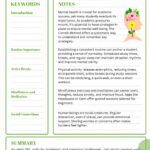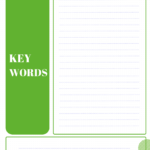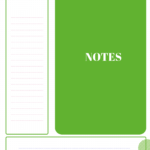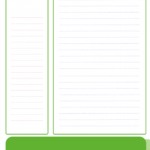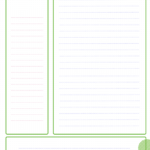Introduction: Developed by Walter Pauk at Cornell University in the 1940s, the Cornell Method offers a systematic format for condensing and organizing notes. The approach avoids the need for continuous recopying and revision, making the studying process more efficient.
Why Choose the Cornell Method? The Cornell Method’s layout divides the note paper into specific sections, ensuring that students capture all aspects of a lecture or reading, from main ideas to intricate details and even personal insights. Over time, this method can enhance active recall and comprehension.
The Structure: The Cornell Method relies on a specific layout to compartmentalize information:
- Cues Column (Left Side):
- Width: Approximately 6.35 cm.
- Purpose: For jotting down keywords, questions, or cues relevant to the notes.
- When to Fill: After the main notes are taken to reflect, test memory, and ensure understanding.
- Notes Column (Right Side):
- The larger section on the right side.
- Purpose: Record real-time notes during the lecture or reading.
- Tips: Aim for conciseness. Use symbols, abbreviations, and focus on capturing key facts, figures, or concepts.
- Summary (Bottom):
- A section reserved at the bottom of each page.
- Purpose: Summarize the main ideas or themes of the lecture/reading.
- Tips: Try to distill your page of notes into a few salient points. Capture the essence.
The Cornell Process in Action:
- During the Lecture/Reading: Use the expansive Notes column to jot down main ideas, details, and facts in succinct, telegraphic sentences.
- Post Lecture/Reading: While the information is still fresh, convert your notes into pointed questions or keywords in the Cues column. This will serve as prompts during your review sessions.
- Active Review: To engage in active recall, cover the Notes column. Use the cues/questions to jog your memory. This technique reinforces neural pathways and aids memory retention.
- Summarizing: Once your note-taking is complete, use the Summary section to consolidate your understanding. It’s an opportunity to reflect on overarching themes and the interconnectedness of ideas.
Benefits of the Cornell Method:
- Structured Format: The distinct sections enable clear demarcation between main ideas, details, and summaries.
- Active Learning: By creating questions in the Cues column, you’re engaging with the material actively, which is proven to improve recall.
- Efficiency: Reduces the need for repetitive re-reading. Instead, you’re actively testing your understanding and filling gaps promptly.
- Versatility: Suitable for lectures, readings, seminars, and even meetings.
The Cornell Method of note-taking isn’t just about jotting down points. It’s about understanding, engaging with the material, and preparing for efficient review. As with any method, the key is consistent practice. Over time, as you adapt and refine your approach, you’ll find that the Cornell Method can be an invaluable tool in your academic toolkit.



